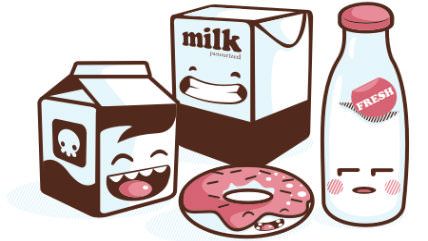Bill Would Ban Connecticut Childcare Providers From Serving Whole Milk
The bill is based more on some legislator's harebrained idea of how nutrition and diet work than any actual nutrition or dietary science.


A new bill making its way through the Connecticut legislature would ban daycare centers and home childcare providers from serving whole milk or 2% milk to the kids in their care. Setting aside for a moment the sheer lunacy of the proposed law's premise, I'd like to point out that it's also based on an incredibly faulty understanding of nutrition.
I rarely drink dairy, but when I do I reach for whole or 2% milk before skim or nonfat varieties. Whole milk is the least processed. Skim milk—you know, the "healthy" option everyone was supposed to switch to at some point in the 1990s—is made by separating and removing the fat from whole milk, which leaves the remaining product a shade of bluish-gray. To make it look palatable, and replace lost protein, milk powder is added back in, via a high-temp, high-pressure process that causes the cholesterol in skim milk to oxidize. Oxidized cholesterol is carcinogenic and has been shown in to promote arterial plaque formation. Oh, and because skimming the fat strips milk of crucial vitamins A and D, synthetic (i.e., less bioavailable) versions of these vitamins are added back into the milk—a sort of pointless procedure anyway, considering our bodies can't absorb these fat-soluble vitamins properly without fat.
Commercial whole milk, while still somewhat processed, is a lot closer to cow's milk in its natural state. No oxidized cholesterol, no need to dye it back to a natural-looking color or add synthetic vitamins. Yes, it has nearly double the calories of nonfat milk—150 per cup, compared to about 80 calories in a cup of skim. But calories aren't everything. Whole milk is richer in protein and fats, which promote satiety and fullness, and feeling full and satisfied longer makes people (including kids) less likely to overeat later.
That's not the only thing fats in milk are good for. They also help slow the release of sugars into the blood stream. Milk is actually more full of sugar than many people realize (in the form of lactose), so this is a helpful feature—almost as if the nutrients in milk naturally complement one another! And though the fat in milk is mostly the saturated kind, it's not necessarily the same type of fat you're getting from French fries and bacon. There are different types of saturated fats, which function different metabolically.
But enough biochemistry and abstraction—doesn't it just make sense that giving kids milk with less fat and less calories would help them avoid unhealthy weight gain? Well, good thing we have research looking at exactly this question in actual kids. A longitudinal Harvard study, published in 2005, found drinking skim or 1% milk was associated with weight gain in 9- to 14-year-olds, while drinking whole or 2% milk was not. A 2013 study found the same associations for pre-schoolers.
So in addition to infringing on personal liberty, the Connecticut bill—"An Act Concerning Nutrition Standards for Child Care Settings"—is based more on some legislator's harebrained idea of how nutrition and diet work than any actual nutrition or dietary science.


Show Comments (50)